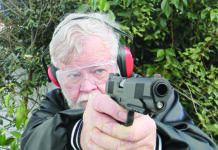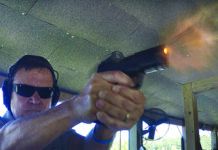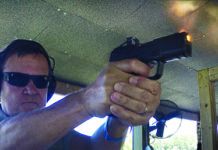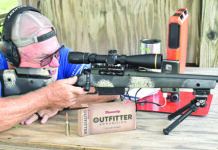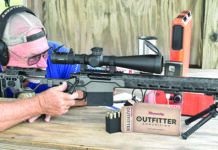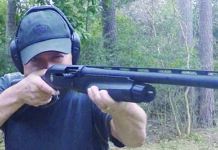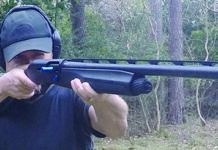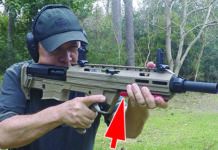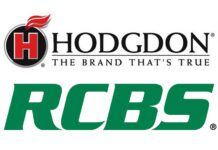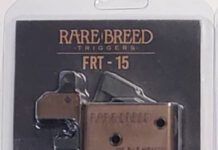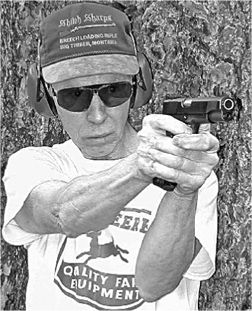
High-grade 1911s can do a multitude of tasks for their owners. The jobs can include NRA target shooting, various action-oriented competitions, hunting, and of course self-defense. In this report we look at two relatively high-dollar 1911s to see how well they might work for any task to which a good .45 might be put. The companies who made the guns suggested these are target-grade or match-specific weapons. Yet each came with very similar and rather special modifications that told us the story only began with accurate target busting.
The pistols were the Match Master by Nowlin ($2,495) and the Limited Match by Rock River Arms ($1,895). Both guns had high-visibility adjustable sights and ambidextrous safeties. They had huge beavertail grip safeties with raised pads. They also had forward-cut, press-checking slots in their slides. Both guns had beautifully done 30-lpi checkering on their front grip straps and straight, 20-lpi checkering on the mainspring housings. They both had Videki triggers (or clones), and high magazine-release buttons. They had huge funnels to take the padded magazines that came with them, something unnecessary on any NRA-type target pistol. Generally, NRA bullseye shooting requires two magazines, yet only one came with each gun, and they were 7-round magazines, not the hottest setup for self-defense, though entirely adequate for most purposes. So what gives? Are these supposed to be target pistols that can also be used for IPSC? Or are they primarily intended to be self-defense (or IPSC competition) pistols that can also be used in NRA target competition? The Nowlin claimed to be set up primarily for NRA bullseye, and the Rock River was designed for Limited IPSC competition. We chose to evaluate these two pistols per the companies’ suggested uses, but also had to consider how well they’d do for other uses, such as for self-defense or action-shooting-competition pistols, since that is how they both appeared to be set up. Here are our findings.
[PDFCAP(1)]
The first thing we noticed about the Nowlin was its attractive appearance. Its slide looked like black glass on each side, with “Match Master” on the left side and “Nowlin” on the right, in attractive script lettering. The right-rear side of the slide also held a monogram labeled “American Pistolsmiths Guild,” and the left-rear corner had Nowlin’s monogram, which was also repeated on the checkered wood grips. The remainder of the metal was finished in a smooth, matte-black finish that cut glare well. The breech of the barrel was well polished, as was the muzzle end, which protruded about an eighth of an inch beyond the barrel bushing.
From the Nowlin website, concerning the Match Master: “This Pistol is most suitable for Bullseye events.” So why does it have a speed-loading well that the company tells us took lots of time and a cost of $215 to fit? No one needs to load fast during an NRA event. The grip is slightly longer on the sides than standard, but anyone who has shot NRA knows that the grip (and control) comes mainly from the front and rear straps. Unless your hand is just plain huge, we doubt the extra length will do you much good. The main reason for such a setup is for speed loading. Most serious NRA competitors put their own custom-fitted grips on anyway. To us, it’s money wasted, if NRA Bullseye is the main purpose of this gun.
The front and rear sights were serrated on the side toward the eye, and had no dots or other fast-acquisition gimmicks. The rear of the front sight blade was angled to permit easier withdrawal from a holster, but that slant does nothing for its visibility against a black paper target. The front blade was dovetailed into the slide and pinned to keep it in place. The edges of the front sight base were cut to match the contour of the top of the slide, a nice touch, we thought. The adjustable rear was by U.S. Tactical Systems and looked like a Bo-Mar. The back of the slide was also serrated to cut glare, and all of the work appeared to be well done. We noticed it was very easy to work the slide of the Nowlin against its recoil spring. Clearly it was set up for target shooting. The literature that came with the gun indicated the “Match Master” is also available in .38 Super and 9×23, though the website information omitted the latter as a standard option. The gun is also available in a hard-chrome finish if desired, at optional extra cost ($170). Many other options are available to please any eye or hand, though it appeared to us you’d need deep pockets to pay for many of the extras.
The slide and frame were both forged, the slide of 4340 steel, the frame of 4140 steel, and the Nowlin barrel was forged also, of 416 stainless steel. Among the other claims were an accuracy guarantee of 1.5 inches at 50 yards and a “Match” trigger pull of 3.5 pounds, which is the NRA minimum for the .45 pistol for standard events. Without doubt the Nowlin’s trigger was among the very best, perhaps the absolute best of all 1911 triggers we’ve experienced. In fact, some of our experienced 1911 shooters had trouble with it, because they were used to triggers that were not as good, and it took them some time to get used to it before they had total control of it. Being the suspicious lot we are, we measured the Nowlin’s trigger and found it to be 1 pound, 14 ounces. That light weight would not be allowed in some competition, we note, including all NRA bullseye events. The NRA requires a 2-pound trigger pull for rimfire and centerfire pistols, and 3.5 pounds for .45s, so the gun, as we found it, was illegal for the particular events for which it was created. That light pull explained our inability to quickly master this trigger. We were all unused to such a light trigger on the 1911. It was the lightest — yet completely reliable — trigger we’ve seen on any 1911 pistol. Whether it’s for you, or not, is your choice.
Now we come to the bad stuff. The Nowlin was nearly useless as a self-defense pistol, because it was chock-full of razor-sharp edges. Yep, those good-looking corners and sharply edged serrations at both ends of the slide have no place on a self-defense gun. Go to any shooting school and you’ll be put through many shooting drills. You’ll also have to go through clearing drills, to learn how to fix any jams you might have in the heat of battle. These drills are essential to learning how to master your handgun. A stovepipe-clearing drill involves raking your weak hand down the top of the gun rearward, and if you do that with the Nowlin, you’ll leave chunks of your hand behind. The rear-sight blade’s forward edges were razor-sharp, as were the front corners of its base. The front of the slide had sharp corners, making it nearly impossible to holster this gun with ease. The bottom edge of the slide was too sharp all along its length. The front of the slide-stop was another knife. The edges of the attractive serrations cut our holsters mercilessly the few times we tried the gun from the leather. Most of the edges of the ejection port were not bad, but could have been better. While we applaud Nowlin for knowing how to make an extremely attractive pistol with a fabulous trigger, the company built a gun that looks like it’s suitable for all types of self-defense shooting, but was not entirely suitable at all. By contrast, the Rock River Arms gun was far better than this one for shooter comfort, at least during clearance drills.
In Nowlin’s defense, this note appears on its website: “We will build [the gun] the way you want it. If you do not want forward cocking serrations, they can be deleted. If you want a short trigger, we will install [one]. If you want a thinner-than-usual front sight, we will thin it. In short, tell us what you want.” That, we thought, was a mighty healthy attitude. Yet many new shooters will not know what is needed, and if they buy this gun and take it to, say, Thunder Ranch for a week of training, they’ll come home with mutilated hands, and probably a mutilated gun from file work done to protect the hands. We feel this file work ought to be done to all 1911s before they leave the factory, and Nowlin certainly ought to know this. The edge-breaking done was insufficient, in our opinion, to what it should have been. Other custom makers such as Robar, Valtro, and Michigun, to name three, all do a more effective job of edge-breaking than Nowlin did here, in our experience. Even the SW1911 was superior for shooter comfort.
[PDFCAP(2)]
On the range we tried five different loads. These were Wolf (Russian) 230-grain hardball, PMC 185-grain JHP, 185- and 230-grain Winchester BEB target loads, and Cor-Bon’s 165-grain JHP. The Nowlin (and the Rock River) showed distinct preferences, so you can expect to do some load-fiddling before you get the finest accuracy out of yours. We have no doubts the Nowlin (and the Rock River) can produce groups as small as claimed. We personally could not do it, but our shooters’ eyes are not all that young nor their holds as solid as they used to be. But our best groups were not far off Nowlin’s claims, and we noticed many groups had three or four shots in one hole and the others just outside, so we give them the benefit of doubt and say they’ll shoot as well as claimed. We shot from a seated, back-rested position on an extremely hot day. A test fixture such as the Ransom Rest would prove the guns’ absolute accuracy, but we prefer to test as you, the shooter, will shoot, by holding the gun in our hands. This, we’ve found, tells us about the shootability of the gun, something a mechanical device cannot do. It is, for example, how we found the light trigger was not all that easy to shoot if you’re not used to it.
Our best groups with the Nowlin were with target-type loads. Our best group was with 230-grain Winchester BEB, 0.8 inches for five shots at 15 yards, with four into one jagged hole. We also tried Federal’s Match ammo with 185-grain bullets in the Nowlin, but that ammo was not significantly better than any of the other brands tried, so we didn’t include it in our test report.
[PDFCAP(3)]
Who made this gun? At first blush we could find no maker’s name anywhere on it. We finally found the maker’s name on top of the rear sight, but it could have been mistaken for the maker of the sight. The barrel was marked, “KART 45 NM.” Did Kart make it? Rock River needs to get its name prominently somewhere on the gun, we thought. Both sides of the slide were bare, no words, but they were polished and could have — and should have — held some sort of logo or name. There was nothing here to be ashamed of. The gun was set up by people who understand what a self-defense handgun should have, we thought. The name of this one proclaimed it to be designed for Limited IPSC events, which some shooters say are as close to the original intent of IPSC as you can get, today. That is to say, Limited IPSC is a game that utilizes guns you might actually carry, in shooting scenarios that are as close to genuine street shootings as may be simulated today. Read that as “self-defense carry gun,” and you’ve got the idea.
We liked this gun right from the start. Most of the edges were tastefully rounded, or broken, everywhere. The gun went into, and came out of, our holster easily. The gun was nicely matte blued, other than the slide and frame sides, which were polished before bluing. The top of the slide had serrations to cut glare. They were cut into a flattened area milled into the top of the slide, and the edge between the two areas had a tasteful groove, a delicate touch that we liked. The sights were excellent, the rear being a Bo-Mar. The front blade was, however, not pinned after dovetailing, nor were the blade extensions cut to match the slide contour, as the website literature claimed. Yet they blended well enough with the flat top of the slide, and looked good and worked well. The rear sight had serrations on its rear surface, but the front edges of its base were a bit sharp. The rear of the slide had serrations to cut glare. The Rock River was set up essentially identically to the Nowlin. However, the RR’s wood grips were far more attractive, better finished, and better checkered than those of the Nowlin. The checkering worked better, too, we thought.
Frankly, some of us are put off by the huge magazine extensions, more like funnels, fitted to both of these handguns. While they may help slightly in competition, we don’t believe they are necessary on the street. They can actually hinder the fast loading of an unpadded magazine, unless you know to keep your weak hand stiff while inserting the magazine. They add bulk to the guns, making them harder to conceal. And some of us think they generally look like the devil, making ‘ol ugly even more homely.
The company website told us the RRA’s frame and slide were forged. It also told us the gun came with guaranteed accuracy of 1.5 inches at 50 yards, and with a one-year limited warranty. A less expensive version was available for $1,510, but had less guaranteed accuracy, 2.5 inches at 50 yards. That might be more than enough for many shooters, and would save nearly $400, and thus would be well worth considering. The ambidextrous safety of our test gun was outstanding in that it didn’t interfere with the hands of a few of our shooters who hate most ambi safeties. This one, they thought, was just great. Workmanship was outstanding throughout the gun, as it was with the Nowlin. There was no shake or looseness to the slide. The slide had a beefy spring within, yet it was easy to chamber a round from a full magazine — unlike our experiences with some 1911s, which balk with a full magazine in place. The Rock River had finer serrations on the slide than the Nowlin, and we thought they worked just as well, looked better, and didn’t score the holster as much. The magazine-release button had an extension, which some shooters don’t like because these can get bumped without the shooter noticing, resulting in a lost magazine on drawing the gun.
So on the surface, the Rock River seemed like the better gun for those with self-defense or action shooting in mind, rather than NRA target activities. How well would the RR handle the latter? We’ll tell you shortly.
At the range, we found zero failures or malfunctions with all loads tried. It was not, we found, necessary to have a super-light recoil spring to handle target loads, at least not during our limited shooting. We found it easier to shoot the Rock River, with its excellent 3.6-pound trigger, than the Nowlin with its sub-2-pound trigger. We got essentially the same accuracy from each of the two test guns. Accuracy results with the RRA Limited Match indicated some preferences, with the 165-grain Cor-Bon and 230-grain Winchester BEB giving the smallest average groups. Yet the smallest cluster, four shots out of a string, was with Wolf 230-grain FMJ (hardball), which was 0.3 inch. Mighty promising, we thought.
Okay, the Nowlin was a little better looking, at first glance, than the Rock River. Yet despite the Nowlin’s looks and amazing trigger, our shooters all said they’d pick the Rock River over the other gun, because of the RR’s ease of shooting, good attention to details about rounding and smoothing, and nicer wood grips. We all preferred the Rock River’s trigger for speed shooting. In our rapid-fire evaluations, we could all hit the target with greater accuracy with the Rock River Arms handgun than with the Nowlin. We suspect this is because we’re far more used to the RR’s trigger pull than the super-light Nowlin’s and felt more at home with it. Perhaps after long use the finer trigger of the Nowlin would be preferable, so we can’t make absolute claims here. You may like a lighter trigger better, and we have little doubt that we’d come to prefer it over time, though as stated it was illegal for bullseye. The RR’s trigger was perfectly legal for all NRA shooting, breaking at just over 3.5 pounds.
We tried both guns NRA-style, shooting offhand at 25 yards at suitable targets, and found we got identical groups with each gun, despite the illegal trigger of the Nowlin. We got the same number of called flyers with each gun, and each gun shot essentially identical group sizes, so with our limited shooting there was no advantage to the super-light trigger. We confess NRA shooting is not something we do frequently, and our results were not what you’d expect from, say, Bill McMillan, but we found out all we’d need to know, which was that either gun would do equally well for NRA competition, but the Rock River Limited Match would do better for self-defense shooting, or for Limited IPSC.
Gun Tests Recommends
Nowlin Match Master .45 ACP, $2,495. Buy It. The Nowlin’s ambidextrous safety was a slight problem for one of our shooters who was not troubled by the Rock River’s safety. Also, we had some concern about shooting high-recoiling loads in this handgun, which had a lighter-than-usual recoil spring, compared to most previously tested 1911s. If a steady diet of hot loads is necessary for your particular shooting game, you should consider a stronger recoil spring or a slide buffer.
Nowlin’s website states that the custom pistols can be tailored to the individual’s needs, and we suggest the prospective buyer contact the company and discuss what is desired before placing an order. The gun needs to be thoroughly deburred for any self-defense-type use, and Nowlin ought to know that. Nowlin can advise the buyer on specific gun setup better than we can, and we suggest you make sure the gun is set up by the maker for your specific uses.
Most NRA shooters won’t need to do anything to the pistol except make sure the trigger is legal, but we think they’ll be paying for more bells and whistles than they need, for such limited use of what can be a versatile handgun. However, we thought the Nowlin was a good gun, with some reservations as noted. It had zero problems or malfunctions.
Rock River Arms Limited Match .45 ACP, $1,895. Our Pick. For the shooter looking for a good overall 1911 handgun that can be used for a variety of uses that could include NRA shooting, bowling-pin competition, or for IPSC or other action shooting, the Rock River would be our first choice of the two tested here. We would not hesitate to carry it for self-defense use, just as it came, though we prefer certain items it didn’t have. It did it all, and though it didn’t look as fancy as the Nowlin, it was extremely tasteful, understated in fact, and did some things much better.



